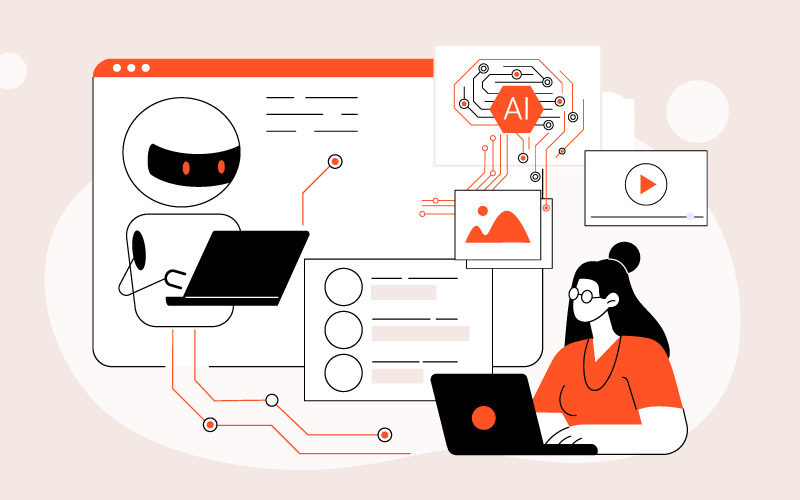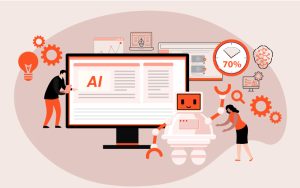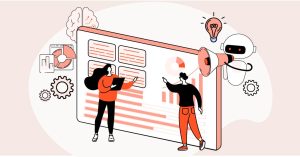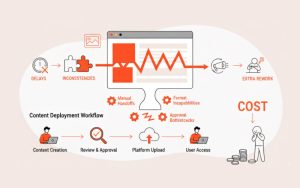When AI Stops Being Someone Else’s Job
Recently, a coworker casually brought up the idea of utilizing ChatGPT to write a project overview. That remark stayed with me, but the conversation swiftly changed topics.
It wasn’t presented as innovation. It didn’t matter much. That’s precisely the point.
AI is becoming woven into day-to-day work, not just in technical roles, but across departments. What was formerly considered “experimental” is now considered normal. However, many professionals still lack the self-assurance, expertise, or assistance necessary to make successful use of these technologies.
If AI skills only exist inside the L&D team, organizations are building castles on sand. Because the success of AI adoption doesn’t depend on a single department. It depends on everyone knowing how to work alongside machines, thoughtfully, ethically, and with purpose.
What AI Literacy Really Means
Let’s be clear: AI literacy is not about becoming a data scientist or building your own chatbot.
It’s about being able to:
-
Determine which tasks AI can automate, enhance, or speed up.
-
To make work easier, use programs like Claude, Microsoft Copilot, or ChatGPT.
-
Create well-structured suggestions that produce safe and helpful results.
-
Consider such results critically.
-
Recognize the practical and ethical ramifications of AI judgments.
AI literacy is about judgment and fluency, not fluency in code. It’s knowing how to integrate AI into your role, whether you’re in customer service, HR, procurement, or project management.
And right now, that knowledge is uneven. Some employees are experimenting on their own. Others are waiting for permission. And too many feel left behind.
Why It Can’t Be L&D’s Job Alone
Learning and Development teams are natural stewards of organizational learning. But when it comes to AI, they can’t and shouldn’t be learning alone.
Why?
Because AI is not just a learning tool. It’s a workflow tool. It’s embedded in writing, editing, summarizing, planning, analyzing, and decision-making. That means it touches nearly every function, not just the ones with “training” in the job description.
Expecting L&D to lead AI literacy without full cross-functional support is like asking the finance team to manage everyone’s project timelines. It simply doesn’t scale.
Instead, we need distributed ownership. We need AI champions in marketing, operations, finance, compliance, and facilities, people who understand the tools in context and can model responsible usage.
And L&D? Their role becomes even more strategic: supporting experimentation, surfacing insights, and embedding AI into real workflows.
The Real Risk: Skill Stagnation, Not Job Loss
There’s a lot of fear around AI replacing jobs. But the more urgent risk is more subtle: being left behind.
McKinsey reports that AI could automate activities that account for up to 30% of hours worked by 2030. Yet less than 20% of employees feel prepared to use AI in their current roles.
That gap doesn’t just affect individual careers. It slows down the entire organization. Teams get stuck waiting for “AI experts” instead of building competence internally. Processes stay manual. Innovation stalls.
In learning theory terms, this is a motivation issue. According to Self-Determination Theory, employees need autonomy, mastery, and purpose to engage with new skills. If AI training feels vague or irrelevant, they’ll disengage.
The solution? Make AI learning tangible. Role-specific. Low-risk. And ideally, a little fun.
Practical Ways to Start, Without Overwhelming Anyone
You don’t need a massive rollout to get started. Here’s how organizations are building AI fluency without overengineering it:
-
Assess the baseline. Send a short survey: How often are people using AI tools? Where do they feel unsure? What are they curious about?
-
Determine which use cases are low risk. Consider inbox triage, data summarization, brainstorming, and outlining. To gain confidence, start with non-sensitive jobs.
-
Host “Prompt Clinics.” Create space for employees to experiment and share what works. Peer learning often sticks better than formal training.
-
Embed into existing tools. If your team is already using Microsoft 365, Canva, or Notion, point out the AI functionality they could be lacking.
-
Create cross-functional AI champions. Find early adopters across departments who can mentor others and share practical insights.
-
Use iterative learning. Borrow from the SAM model: prototype, test, adapt. The tech changes fast, your learning model should too.
Closing the Gap, One Team at a Time
AI is reshaping work. That’s not speculation. It’s already happening, quietly, quickly, and across every industry.
The question is no longer “Should we train our people on AI?” It’s “How do we make AI literacy everyone’s business?”
The answer lies in shared responsibility. In culture, not just courses. In role-based relevance, not generic toolkits.
BrinX.ai helps organizations take this leap with scalable, role-specific AI upskilling programs designed for real work. If you’re ready to democratize AI fluency, without overwhelming your teams, we’d love to help.
Let’s move beyond awareness. Let’s build capability.

FAQs
What is adaptive learning, and how does AI contribute to it?
Adaptive learning adjusts the experience to the performance, preferences, and speed of individual learner. By altering the trip based on real-time data analysis of what a learner clicks, skips, or struggles with, artificial intelligence improves this.
Can AI really generate full courses from raw content?
Yes. Certain AI-powered services can analyze SOPs, manuals, and slide decks to generate structured modules with assessments and objectives. Although they significantly cut down on production time, these drafts still benefit from human inspection.
How is gamification supported by AI?
AI doesn’t create game mechanics, but it sets the foundation. It structures learning into modules, which instructional designers can then gamify, adding points, scenarios, or progress indicators that motivate learners.
What’s the benefit of combining AI and microlearning?
Complex material is decomposed by AI into goal-aligned, modular building pieces that are ideal for microlearning. This facilitates the creation of brief, efficient, and time-spaced learning excursions that improve retention.
Is this approach scalable across a global workforce?
Yes. AI-assisted course development is particularly effective at scaling training in domains where consistency is crucial and source information is already available, such as compliance, product knowledge, and onboarding.
Do I need to buy a platform to use this kind of AI course builder?
Not always. Some services, like the one developed under MITR, offer course generation as a project-based model, no platform lock-in, no licenses, just a secure workflow and editable output.
Can human instructional designers still add value after AI builds the draft?
Absolutely. In fact, they’re essential. AI handle’s structure and speed; humans bring voice, empathy, and interactivity. It’s not either-or, it’s a partnership.
How secure is this process when using sensitive documents?
Best-in-class tools encrypt content, never store source material beyond delivery, and meet enterprise privacy standards. Always check for data handling policies before sharing internal content.

Soft Skills Deserve a Smarter Solution
Soft skills training is more than simply information. It is about influencing how individuals think, feel, and act at work, with coworkers, clients, and leaders. That requires intention, nuance, and trust.






